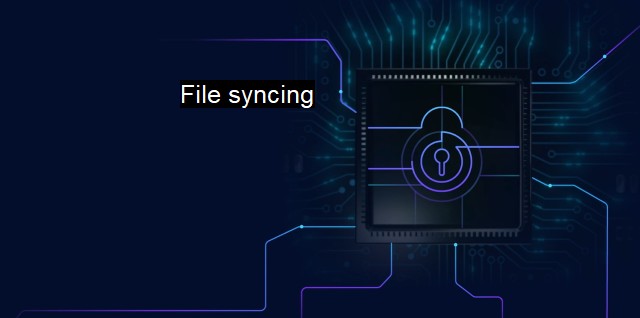What is File syncing?
Strengthening cybersecurity through file synchronization: A comprehensive guide for individuals and businesses
File syncing, or file synchronization, is a critical concept when it comes up to cybersecurity and antivirus protection. This process refers to the act of keeping files consistent and updated across several systems or within a network environment. This technique is utilized to keep all of a user's files readily available, updated and accessible from multiple devices or various locations. File syncing delivers efficiency by ensuring that individuals or entities have identical, up-to-date versions of everything, saving time and resources. Domains like remote work scenarios, business collaborations, or personal data management largely rely on file syncing technologies.Although it appears straightforward, there can be much complexity to file synchronization. There is one-way file syncing which updates files from a source to a target location, and there's two-way syncing, which not only updates the target when changes are made to the source but also updates the source when changes are made to the target. Therefore, businesses usually opt for sophisticated tools that can deal accurately with conflict resolution for cases like simultaneous modifications or file deletions.
The context of file syncing has raised significant cybersecurity concerns because it involves the transmission of potentially sensitive data across networks, opening up vulnerabilities that cybercriminals could potentially exploit. Cybersecurity breaches in file syncing can lead to severe repercussions, including data corruption, theft of sensitive data, and interruption of business operations.
A critical security concern in regards to file syncing is the creation and transmission of duplicates or modified versions of original files. Since the process involves constant updates to keep files in sync across different platforms, any malicious alterations to source files can potentially be propagated throughout the network. File sync solutions mitigate this threat by proactively checking for unauthorized modifications, using techniques such as file verification or hashing, guaranteeing the fidelity and integrity of the data by confirming it has not changed during transmission.
Cybersecurity’s role in file syncing is multifaceted, extending from the authentication process to monitoring for anomalies and then acting to defend against cyber threats. To secure endpoints in a file syncing network, strong authentication protocols are needed to ensure that only authorized users can access files. This can be enhanced using multi-factor authentication (including biometrics), which provides an additional layer of security. Plus, encryption algorithms both in-transit and at-rest play a vital role in protecting the entire life cycle of the data being synced.
The connection between file syncing and antivirus solutions is undeniable. An active and robust antivirus regularly scans files before they are opened, written, or synced, seeking signatures aligned with known viruses, ransomware, or other types of malware that may interfere with or harm the user's data. The constant data flow across devices and platforms could inadvertently distribute a potentially harmful file, making regular virus scans critical. A synced network is only as secure as its weakest link, and introducing a virus into such a network can have devastating ramifications.
A form of protection is heuristic file scanning, which involves examining the substance of files for characteristics typically present in harmful software, offering an extra layer of security beyond just signature-based detection. This is critical due to the ever-evolving nature of cyber threats, many of which are designed to evade traditional antivirus scans.
In the cybersecurity space, new advancements regularly surface translating into updated and improved file-syncing systems. With them come new vulnerabilities and cybersecurity challenges as well. Organizations must focus on combining robust antivirus protection, encryption of data, and solid user authentication to secure any file syncing mechanism. Rigorous scrutiny in managing access rights to minimize shared information exposure, additional scrutiny on when and where syncing happens, analyst threat intelligence feeding systems, adaptive auditing practices highlight some areas messed within modern cybersecurity.

File syncing FAQs
What is file syncing?
File syncing, also known as file synchronization, is the process of ensuring that files in two or more locations are exactly the same. This is achieved by copying and updating the files from one location to the other, so that they are identical.Why is file syncing important for cybersecurity and antivirus?
File syncing is important for cybersecurity and antivirus because it ensures that all files are up-to-date and consistent across different devices, networks or locations. When files are synced, it allows antivirus software to scan and protect them, making it more difficult for malware and other cyber threats to enter the system.What are some common file syncing tools used for cybersecurity and antivirus?
Some common file syncing tools used for cybersecurity and antivirus include Dropbox, Google Drive, OneDrive, and Box. These cloud-based file syncing services allow users to store and access files from anywhere, while also providing security features such as encryption and two-factor authentication.How can I ensure that my file syncing activities are secure?
To ensure that your file syncing activities are secure, you should use reputable syncing tools that provide strong security features such as encryption, two-factor authentication, and access controls. Additionally, you should regularly update your antivirus software and perform regular scans to detect any potential threats or vulnerabilities. It is also important to use strong passwords and avoid sharing access to your files with unauthorized users.| | A | | | B | | | C | | | D | | | E | | | F | | | G | | | H | | | I | | | J | | | K | | | L | | | M | |
| | N | | | O | | | P | | | Q | | | R | | | S | | | T | | | U | | | V | | | W | | | X | | | Y | | | Z | |
| | 1 | | | 2 | | | 3 | | | 4 | | | 7 | | | 8 | | |||||||